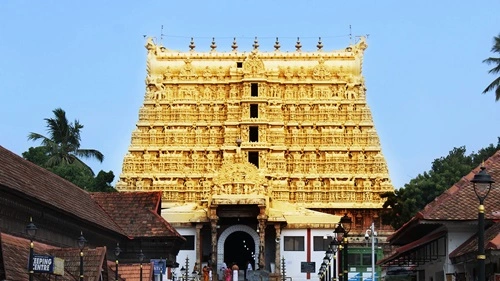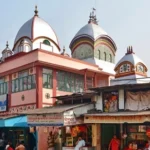Padmanabhaswamy Temple in Thiruvananthapuram, Kerala, is a monument of devotion, grandeur, and mystery, drawing visitors from across the world. Dedicated to Lord Vishnu, this ancient temple is famous for its Dravidian architectural style, intricate carvings, and sacred sanctum. In recent years, it has gained global fame for its hidden treasures, estimated to be worth billions, making it one of the wealthiest temples globally. As one of the 108 Divya Desams, the holiest abodes of Vishnu, Padmanabhaswamy Temple stands as a beacon of spirituality and architectural marvel, inviting visitors year-round.
Understanding the best time to visit Padmanabhaswamy Temple can help you appreciate its spiritual aura, witness local festivities, and make the most of Kerala’s inviting weather. Here’s a guide to planning a memorable trip to this sacred temple.

Exploring Padmanabhaswamy Temple’s Heritage
The history of Padmanabhaswamy Temple dates back centuries, with mentions in ancient texts and a close association with the Travancore royal family, who remain its custodians. The temple is renowned for its deity, Lord Vishnu, depicted in a reclining posture on the sacred serpent Anantha, a unique representation that draws devotees in search of blessings and solace. The temple’s rich culture, historical depth, and architectural magnificence make it a pilgrimage site that embodies Kerala’s spiritual essence.
Best Seasons to Visit Padmanabhaswamy Temple
1. Winter (October to February)
Winter is widely regarded as the best season to visit Padmanabhaswamy Temple, as the weather is cool and comfortable, with temperatures ranging between 20°C and 30°C. This period offers the ideal climate for exploring the temple and the surrounding areas without the discomfort of Kerala’s humid summer and heavy monsoon. Winter in Kerala allows travelers to immerse themselves in the serenity of the temple while enjoying pleasant weather conditions.
One of the highlights of visiting during winter is the festival of Makaravilakku, celebrated in January. Although this festival is primarily associated with Sabarimala, it has significance at Padmanabhaswamy Temple as well, with devotees gathering for special rituals and prayers. Additionally, the temple becomes vibrant with the annual Alpashi Utsavam, a festival that usually takes place in October or November. This event includes elaborate processions, cultural performances, and traditional Kerala rituals, offering visitors a unique opportunity to experience the rich traditions of Kerala.
Winter also provides a great chance to explore other attractions in Thiruvananthapuram, like the nearby Kovalam Beach, Napier Museum, and the Kerala Government Secretariat, making it an enriching experience beyond the temple.
2. Monsoon (June to September)
The monsoon season transforms Kerala into a lush green paradise, with its famous backwaters and landscapes rejuvenated by the rains. While the heavy rainfall can make travel challenging, the atmosphere during this season is peaceful and inviting, especially for those seeking a tranquil experience at the temple. The temple grounds, washed clean by the rains, take on a serene beauty, enhancing the spiritual atmosphere.
One notable festival during the monsoon season is the Aadi Utsavam, usually held in July or August. This festival celebrates the monsoon’s arrival and is accompanied by special prayers and ceremonies at Padmanabhaswamy Temple. Visiting during the monsoon allows you to enjoy the temple in a quieter setting, as fewer tourists tend to come during this period. However, it is essential to carry rain gear and plan your travel around the weather conditions, as Kerala’s monsoon rains can be intense.
For visitors interested in Ayurveda, monsoon is considered an ideal season for Ayurvedic treatments, as the humid climate opens up the body’s pores, allowing for better absorption of herbal therapies. Thiruvananthapuram is home to several reputed Ayurvedic centers where you can indulge in authentic Kerala wellness practices after your temple visit.
3. Summer (March to May)
Summer in Kerala can be hot and humid, with temperatures often reaching 35°C or more. Although it may not be the most comfortable season for travel, visiting during summer has its advantages. For those who prefer fewer crowds, summer offers a quieter experience, allowing devotees to spend more time in meditation and prayer without the large influx of winter tourists. Early mornings or late evenings are the best times to visit the temple during this season, as the temperatures are lower and more manageable.
Despite the heat, there is an important celebration during this season: the Painkuni Festival, a major event held in March or April. This festival is marked by grand processions and elaborate rituals, with the Travancore royal family’s involvement adding to its significance. Painkuni is dedicated to Lord Vishnu and celebrates his divine presence in Kerala. The temple becomes a hub of activity, with the towering wooden statues of Pandavas, the five legendary brothers, erected for the festivities. This unique celebration provides a glimpse into Kerala’s royal traditions and cultural heritage.
Practical Tips for Visiting Padmanabhaswamy Temple
- Dress Code: Padmanabhaswamy Temple has a strict dress code, requiring men to wear dhotis and women to wear sarees or long skirts and blouses. Western attire is not allowed, and dhotis can be rented or purchased near the temple.
- Entry Rules: Only Hindus are allowed entry into the temple. Visitors are advised to check with local authorities or temple staff about entry guidelines.
- Timing: The temple has specific visiting hours, with early mornings and evenings being the most popular times for darshan. Visiting early also allows you to avoid crowds and participate in the morning rituals.
- Nearby Attractions: Consider exploring nearby attractions like Attukal Bhagavathy Temple, Kuthiramalika Palace Museum, and the serene beaches of Kovalam and Varkala.
- Local Cuisine: Kerala is known for its distinctive cuisine, including dishes like appam, stew, dosa, and traditional Kerala sadhya (a multi-course vegetarian meal). Try the local food around Thiruvananthapuram for an authentic culinary experience.
Conclusion
Padmanabhaswamy Temple is a timeless symbol of devotion, history, and Kerala’s cultural richness. From the festive atmosphere of the winter season, the tranquil ambiance of the monsoon, to the quiet reflection of summer, each season brings its own charm to this sacred place. Whether you’re attending a vibrant festival, exploring the temple’s architectural wonders, or simply seeking spiritual solace, choosing the right time to visit can help you fully immerse in the divinity and heritage of Padmanabhaswamy Temple. Embrace the spirituality, and let Kerala’s vibrant culture leave a lasting impression on your journey.


